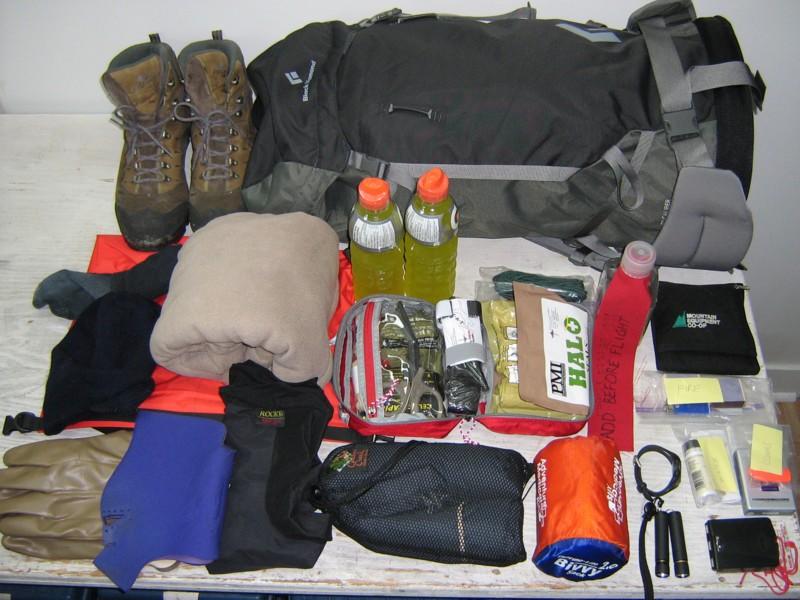
Overview of the Bug-Out-Bag.
Let's Adore Jesus-Eucharist! | Home >> Varia >> Bachelor's Kit

Overview of the Bug-Out-Bag.
1) Introduction
2) Keep your head on your shoulders! (Will and skills to survive)
3) Scoot or Shoot! (Self-Defense)
4) Plug bloody leaks! (Emergency First Aid)
5) Keep warm and dry! (Clothes)
t40) Rain jacket and rain pants
t41) Wool tuque
t42) Wool socks
t43) Waterproof gloves
t44) Waterproof socks
t45) Fleece Jacket
t46) Neoprene face mask
t47) Lightweight waterproof bag
t48) Bivouac sack
t50) Bottles of water and electrolytes
t51) Water purification chemicals
7) Call your friends! (Communications)
t60) Small shortwave radio
t61) Spare cellular telephone battery (charged)
t62) Little plastic whistle
8) Find another home! (Navigation and Transportation)
9) Stay integrated with society! (Official Documents and Money)
10) Stuff that didn't fit in the above categories
A "Bug-Out-Bag" (or just BOB) is related to the "Cardinal Rule of Disaster Preparedness", which tells us that when something really bad happens, usually the best thing to do is to "bug-out", to get out of the way of this uncontrollable disaster. And because the least unreliable means of bugging out we have is to get up and run with whatever we can physically carry, we usually talk about a "bug-out bag" (and not a bug-out fork lift pallet or a bug-out freight train).
Ideally, you bug-out with everything you need to live, for as long as the disaster will last. In reality, that's often impossible. For example, the average man needs about a gallon of water a day. Go out and try to run with 10 days worth of water! You won't run very far! So "everything you need to live" becomes "as many high-priority survival objects you can fit in a knapsack that you can pick up and put on your shoulder with only one hand".
In my opinion, this "one-hand pickup" rule-of-thumb better expresses the nature of the BOB, than the common idea that such a bag must contain what we need to survive for 72 hours. Moreover, it's very easy to fill a container and say to oneself: "yeah, I can still carry that", even though you can't. Finally, remember that the Bug-Out Bag is just one option in a whole spectrum of choices. The actual situation will dictate what you will carry with you.
In theory, your keep your bug-out bag packed and close to you at all times. In practice, it's not easy to drag a heavy bag with you in church, at work, in the swimming pool, etc.! So you do your best to keep it as close and as ready as possible. For example, if you own a car and are often on the road, having a bug-out bag in the car is probably a good idea. Also, before you are about to become more vulnerable (like before you go to sleep for the night, etc.), it's a good idea to keep it a bit closer and a bit more ready.
I tried to divide this list into "action categories" as opposed to more "academic" classifications. In other words, I tried to group the contents of the BOB according to the things you have to do, and the order in which you normally have to do them, if you want to stay alive when the SHTF:
- Keep your head on your shoulders! (Will and skills to survive).
- Scoot or Shoot! (Self-Defense).
- Plug bloody leaks! (Emergency First Aid).
- Keep warm and dry! (Clothes).
- Urinate clear! (Hydration).
- Call your friends! (Communications).
- Find another home! (Navigation and Transportation).
- Stay integrated with society! (Official Documents and Money).
Please remember this classification is not rigid or exhaustive, but just a way of transforming your BOB into a "survival cheat sheet".
Finally, the first item in the Bug-Out Bag is of course everything in your EDC!
This is the most important category in the bug-out bag, but there is only one object in it: a little field notepad filled with (among others) encouragements and good survival advice.

Description: See The Field Notepad
Price: 10$
The first priority is to stay alive, either by running away from immediate threat or rarely by fighting it. The only item in this category is the backpack, the actual bag of the Bug-Out Bag, which symbolizes the "Scoot" part of the "Scoot or Shoot!" advice. If I lived in the USA, I would also put in this category some kind of defensive firearm with some ammunition. You could also argue that the EDC knife belongs in this category.
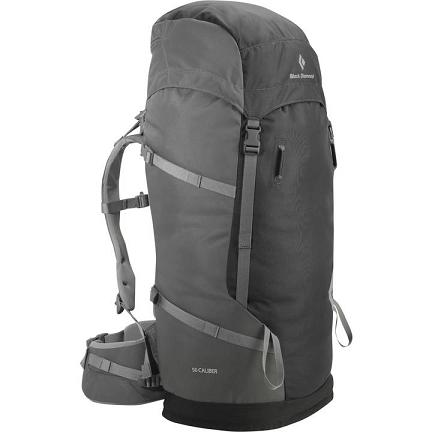
Description: A backpack, bigger than a daypack but smaller than an expedition pack, with hip belt, and some sort of simple internal frame (to transfer some weight to the hips). These days a www.MEC.ca Black Diamond 50 Caliber.
Design: I haven't seen many bad backpacks these days. They all seem pretty good to me. I tend to prefer models that have fewer and bigger pockets, and I tend to cut off some straps which I find excessive. I also prefer packs that look as boring as possible (dull colors, simple shape). My current BOB backpack is only about half-full when I've put all my stuff in it, and I like it that way. We always have last minute additions.
Price: 153$
See Gunshot Wound Kit. (This doesn't imply wounds are only caused by guns, but rather that we're talking about emergency medical care, just enough to keep the patient alive while you are bugging out.)
Heat stroke can kill you, but normally drinking lots of water ("urinate clear!") and staying in the shade will avoid such problems. The more frequent threat is hypothermia, since low body temperatures can kill you in a few hours (and even minutes, if you fall into cold water).
Some comments on the items of this category:
- Most of the items listed here are rather thin and fragile. If I had time,
I would put on my normal clothes appropriate to the current weather, but at
least what is listed here would keep me alive even if I ran out of the house
wearing only
my pants.
- Wool is preferred insulator for extremities (better resists compression
and abrasion), fleece for the rest. No cotton ("Cotton kills", as old
mountaineers say).
- Normally survival and esthetic considerations don't go together, but in the
case of clothes, we must
be careful about how we look.
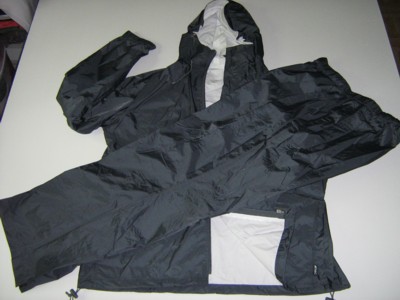
Description: Waterproof (not breathable) lightweight jacket and pants, with sealed seams.
Use: Sometimes the inner waterproof layer sticks to itself. A bit of baby powder often helps before packing it tight for a long time.
Price: 80$
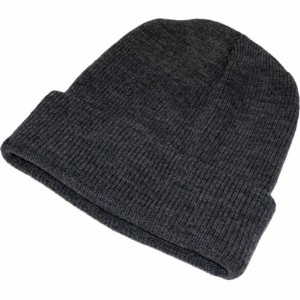
Description: Plain ordinary wool tuque. ("If your feet are cold, put your tuque on!", as old mountaineers say).
Price: 14$
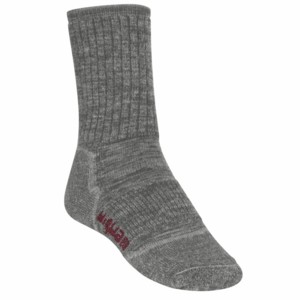
Description: Plain ordinary wool socks.
Price: 16$

Description: There are all kinds of fancy "waterproof" gloves out there. This is just something cheap to protect the hands from injuries and the wool gloves from water.
Price: 10$

Description: Not sure about this one. It's an attempt to keep the wool socks sort of dry, despite the fact I don't know what footwear I'll be able to grab as I'm running away. I guess they would be better than nothing.
Price: 65$

Description: Ordinary fleece jacket. In the old days, this would have been a wool sweater, but fleece dries much faster.
Price: 40$

Description: Home-made, inexpensive, very important.
Price: 2$

Description: Basically a plastic bag, but just a bit more resistant and easier to close in a waterproof way.
Includes: All insulators (wool gloves, socks, tuque, fleece jacket).
Price: 20$
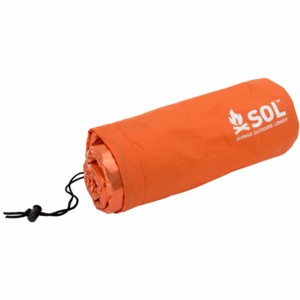
Description: Basically two large garbage garbage bags taped together to make one really long bag, but just a bit more resistant. Never used one, but I assume would be better than nothing.
Price: 15$
If cold can kill you within a few minutes, dehydration can kill you within a few days. A rule-of-thumb to know if you are drinking enough water is that your urine will be clear, not dark yellow.
I have nothing against food in a BOB. It's just mine was already too heavy, and we can live several weeks without food.
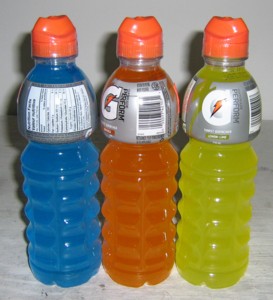
Description: Just a few bottles of ordinary water. I use commercial products because: (i) it's a lazy way of getting water that will remain drinkable until the indicated "best before" date; (ii) by having a bit of salt, and potassium in the water, it's an easy way of keeping electrolytic balance despite strenuous exercise (like running away with a heavy backpack on a hot day!); (iii) the sugar provides a bit of food energy (to run farther!).
Quantity: Water is bloody heavy. Moreover, just one water container is asking for trouble (what if it springs a leak?). So I guess two or three bottles of about one liter each.
Price: 15$
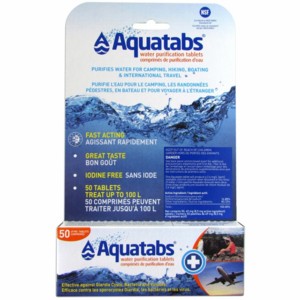
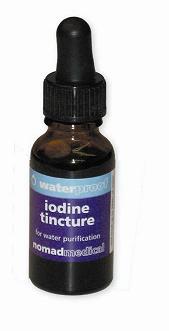
Description: When the commercial water bottles are empty, something to put in them to try to disinfect whatever water we will find.
Use: Chlorine pills: Half a pill per one-liter bottle. Not effective against cryptosporidium. 2% Tincture of iodine: 5-10 drops per liter (depending on how dirty). Iodine has many counter-indications: pregnant women, people with thyroid problems, everybody if you are going to use this method for a long time. In both cases, avoid treating cold water, and wait 30 minutes at least before drinking.
Quantity: They are very light and small. I guess enough for treating ten days worth of water.
Price: 20$
Whatever the disaster, you're better off finding as many people as possible who want to collaborate with you to survive. If I had the money and the licenses, I'd put here some military-style walkie-talkies. Also, the mirror on the compass can be used for signaling.

Description: Something to listen to news and public service announcements.
Price: 40$
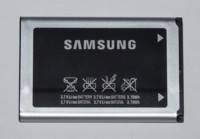
Description: Whatever your cell phone needs.
Price: 20$
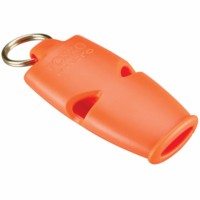
Description: Lightweigt, tiny, and very useful to call for help.
Price: 2$
Whatever the disaster, we can't really live long on the road. Whether we come back to our original home, or travel to a planned "bug-out location", or other, we need to quickly find another home.
Also, I'm putting boots here (it's Transportation!), but of course it's mostly symbolic. Hopefully you'd be able to hitch a ride with somebody else, or ride your bicycle, etc.
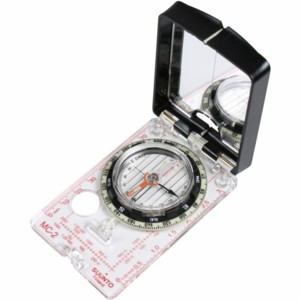
Description: Ordinary plastic compass. One with a little mirror is handy also for signaling.
Use: A bit of training and practice is needed to properly use a compass. Topographical maps of the area you plan to be in during a disaster are also handy.
Price: 30$
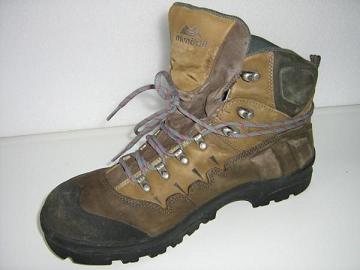
Description: Hiking boots, midweight, preferably Gore-Tex lined. The civilian equivalent of combat boots.
Use: In an emergency, this is the footwear you put on. So these boots remain "slipper-laced", i.e. laced-up and tied-up just barely loose enough so you can slip them on like slippers. I don't pack them in the BOB, normally I try to avoid using them to spare them, and I put them close to my bed before going to sleep.
Price: 230$
Errors: Actual military combat boots. They go up too high, so you can't slide into them like slippers in an emergency. Going too low isn't better, jogging shoes or hiking shoes don't protect and support the ankle enough (yes, I've broken my ankle wearing only jogging shoes in the winter).

This is just whatever doesn't fit in the EDC wallet, like passport, various certificates (Birth, Baptism, etc.), less-important cards (hospital, social insurance, etc.), a bit more cash, etc.
My "action category" classification is far from perfect, so some objects don't fit. Most of them are spares for things already in the EDC:
- backup
knife
(for example, if I'm currently carrying a jackknife in my EDC, then I'll
put my fixed-blade outdoor knife in my BOB).
- one or two backup
flashlights
with several spare batteries.
- backup
backup copies
(yes, I have two sets of backup copies of the contents of my laptop).
- backup
watch.
- backup
lighter,
with a few packs of waterproof matches.
- a bit of paracord and duck tape.
Also, because I can't keep everything in my BOB at all times (like my EDC, my boots, etc.), I have a placeholder object to remind me of what needs to be added when an emergency occurs. It's just an empty water bottle with a red rag screwed under the cap. On the bottle I wrote the list of things I need to add to complete the BOB, and on the red rag I wrote in big letters: "ADD BEFORE FLIGHT", a bit like what they have on airplanes to remind the ground crew of removing them before the airplane leaves.
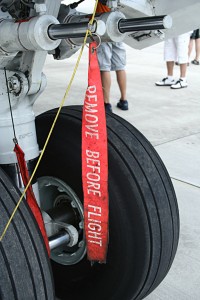
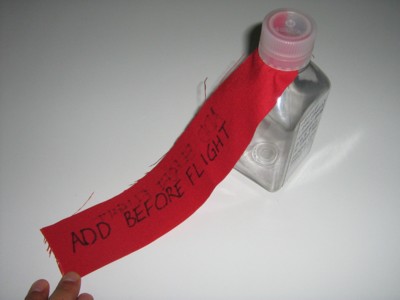
Let's Adore Jesus-Eucharist! | Home >> Varia >> Bachelor's Kit